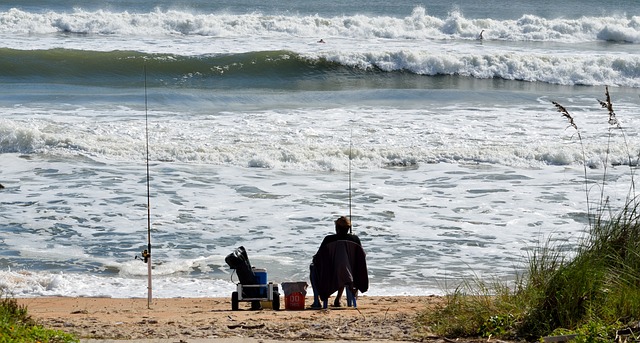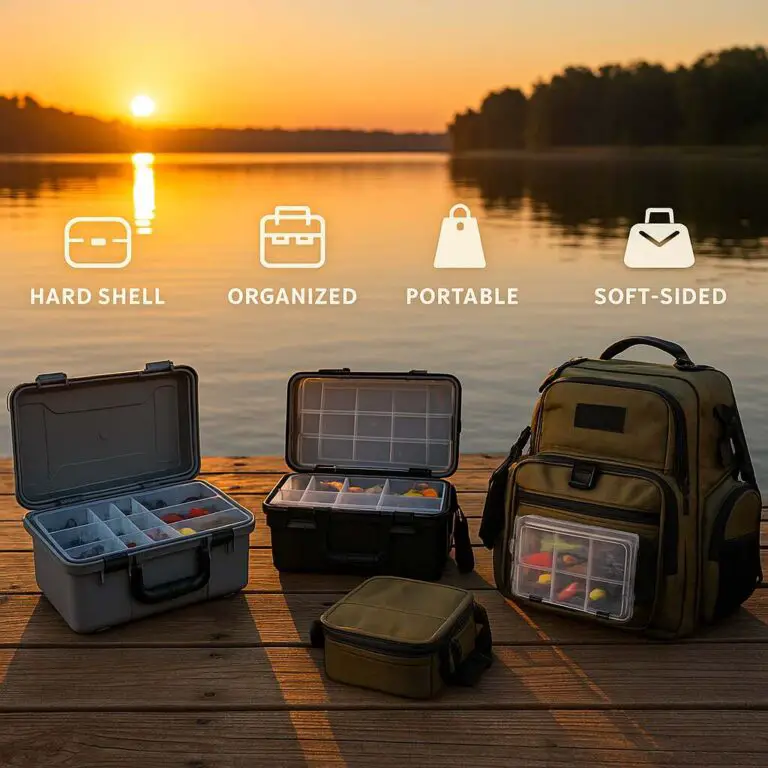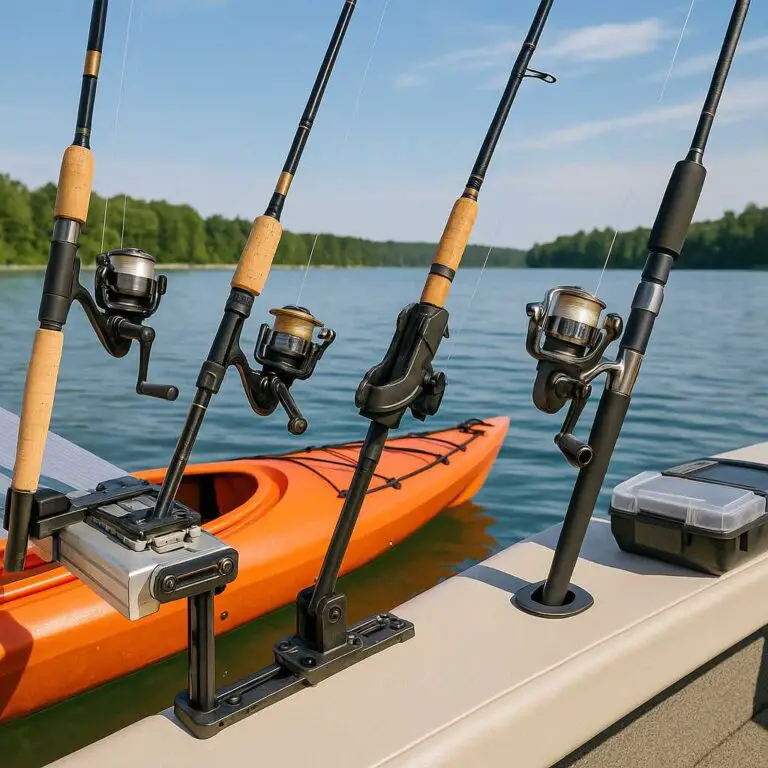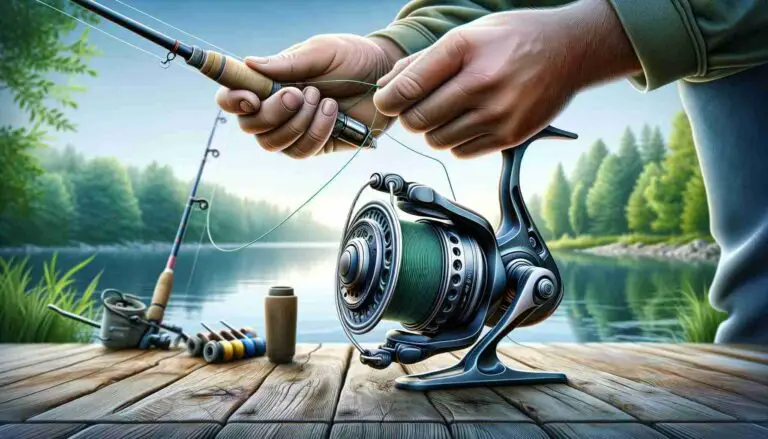In my years of surf fishing, I’ve come to understand one essential truth: having the right surf fishing rod can make all the difference between a successful day on the beach and going home empty-handed. That’s why I’m excited to share this comprehensive guide with you. I’ll dive deep into the world of surf fishing rods, exploring everything you need to know to make an informed decision when choosing your next piece of gear.
So, whether you’re a seasoned surf fishing pro or just getting started, join me on this journey as I unravel the secrets of surf fishing rods, discuss the various types, materials, and features, and even explore some personal recommendations. By the end of this article, you’ll be well-equipped to ride the waves with confidence, knowing you’ve got the perfect rod in hand. Let’s get started!
Understanding Surf Fishing Rods
What is a Surf Fishing Rod? When I talk about surf fishing rods, I’m Talking about the specialized fishing equipment designed to tackle the unique challenges presented by coastal and surf fishing. These rods are purpose-built to handle the demands of casting into the ocean’s tumultuous waves, fighting strong currents, and bringing in saltwater-dwelling giants.
- Definition and Purpose: Surf fishing rods are longer and more robust than your typical fishing rod. They’re crafted to deliver powerful casts over long distances, making them essential tools for anglers targeting fish species that inhabit the surf zone, such as striped bass, redfish, pompano, and more. Whether you’re standing knee-deep in the surf or perched on the shoreline, the surf fishing rod is your key to reaching those fish.
- How it Differs from Other Fishing Rods: Surf fishing rods stand apart from their freshwater counterparts in several ways. Their length, often ranging from 9 to 15 feet or more, gives them the casting distance needed to reach the fish swimming beyond the breakers. Additionally, they’re built to withstand exposure to saltwater, which can be corrosive to regular fishing gear. With their extra length, power, and durability, surf fishing rods are your trusted companions for battling the surf and landing those saltwater trophies.
Types of Surf Fishing Rods
Surf fishing isn’t a one-size-fits-all endeavor, and neither are the rods designed for it. There’s a variety of surf fishing rods available, each catering to different preferences and scenarios.
- Spinning Rods: Spinning rods are among the most popular choices for surf fishing. They’re versatile and user-friendly, making them an excellent option for beginners. With a spinning reel, you can cast lures or bait with ease, making it easier to tackle a wide range of fish species.
- Casting Rods: If you prefer the accuracy and power of a baitcasting reel, there are surf casting rods designed specifically for this setup. They offer precise control over your casts and are favored by experienced anglers seeking longer casting distances and the ability to handle heavier lines and lures.
- Telescopic Rods: Telescopic surf fishing rods are prized for their portability. They collapse into a compact size for easy transport and storage, making them ideal for anglers who need to hike to their fishing spots or have limited storage space.
- Custom-built Rods: For the most dedicated surf anglers, custom-built surf fishing rods offer the ultimate in personalized performance. You can work with a rod builder to craft a rod tailored to your unique fishing style, preferences, and target species.
- Pros and Cons of Each Type: Each type of surf fishing rod has its strengths and weaknesses, and we’ll delve deeper into these attributes to help you make an informed choice. Whether you’re looking for casting distance, precision, or convenience, there’s a surf fishing rod type that suits your needs.
With an understanding of what surf fishing rods are and the various types available, we’re well on our way to finding the perfect rod for your next surf fishing adventure.
Choosing the Right Length
Now that I’ve covered the basics of surf fishing rods, let’s tackle one of the critical factors in selecting the perfect rod – its length.
Importance of Rod Length:
Surf fishing rods come in a range of lengths, from relatively short to impressively long. The length of your rod plays a crucial role in your overall fishing experience, and here’s why it matters:
- Casting Distance: Longer rods typically allow for longer casting distances. This can be a game-changer when you need to reach fish that are feeding beyond the breaking waves.
- Line Control: Longer rods provide better control over your fishing line, especially in strong surf conditions. This control is essential for working lures or bait effectively.
- Fish Handling: The length of your rod affects how you fight and land a fish. Longer rods can provide more leverage when battling large or stubborn species.
Factors to Consider When Selecting Length:
To determine the ideal rod length for your surf fishing adventures, consider the following factors:
- Surf Conditions:
- In calm conditions with small waves, a shorter rod may suffice.
- In rough surf with big waves and strong currents, a longer rod can help you cast beyond the turbulence and keep your line steady.
- Casting Distance:
- Think about the typical casting distance you’ll need to reach the fish you’re targeting. Some species stay close to the shore, while others require you to cast out farther.
- Fish Species:
- Different fish species inhabit various depths of the surf zone. Research your target species to understand their typical location and depth.
Recommended Lengths for Different Scenarios:
- Short vs. Long Rods:
- Shorter surf fishing rods, typically in the 9 to 11-foot range, are excellent for beginners and for fishing in tighter spaces.
- Longer rods, 11 to 15 feet or more, excel in situations where you need to reach fish further from shore or when dealing with challenging surf conditions.
Selecting the right length for your surf fishing rod is a crucial step in optimizing your fishing experience. It can mean the difference between landing the catch of the day and missing out.
In the next section, I’ll delve into another essential aspect of surf fishing rod selection – understanding rod action and power.
Action and Power: What Does It Mean?
Alright, hang tight, because understanding rod action and power is like unlocking the secret sauce to surf fishing success. Let’s break it down.
Explanation of Rod Action and Power
Rod Action: Think of rod action as your surf rod’s flexibility and responsiveness. It’s all about how the rod bends when you apply pressure to it, and in the world of surf fishing, you’ll encounter three main types of rod action:
- Fast Action: These rods bend mostly at the tip, which means they’re super sensitive and great for quick hook sets. Perfect for casting long distances and detecting even the subtlest of bites.
- Moderate Action: These rods flex more along their length, striking a balance between sensitivity and versatility. They’re forgiving and can handle a wide range of fishing styles and lure or bait weights.
- Slow Action: Slow-action rods bend significantly along their entire length, offering a more delicate presentation and superior shock absorption. They shine when it comes to battling larger fish in rough surf conditions.
Rod Power
Rod power tells you about the rod’s strength and its ability to handle different line weights and lure sizes. Here’s how it typically breaks down:
- Light Power: These rods are your go-to for smaller fish species and lighter lines. Great for beginners and a relaxed day of fishing.
- Medium Power: The middle ground, offering versatility for various surf fishing situations and fish sizes.
- Heavy and Extra-Heavy Power: These rods pack a punch, making them perfect for handling big and powerful fish found in the surf, like striped bass, sharks, or redfish.
Matching Action and Power to Your Fishing Style:
Finding the perfect action and power combo depends on your fishing style, target species, and the conditions you’ll be up against.
Light vs. Heavy Action:
- Light action rods are all about finesse fishing and delicate presentations.
- Heavy action rods are your heavy hitters, designed to take on larger fish and handle beefier lures or baits.
Ultra-Light to Ultra-Heavy Power:
- Ultra-light power is for the small fry and lighter tackle.
- Ultra-heavy power is your best friend in challenging conditions and when you’re gunning for the big boys.
How to Choose the Perfect Action and Power for Surf Fishing:
- Tailoring it to Your Target Fish:
- Research the specific fish you’re aiming for and match your rod’s action and power to their behavior and size.
Understanding rod action and power gives you the upper hand when selecting the right surf fishing rod. Next up, I’ll dive into the materials that make these rods tick, an equally crucial aspect of finding your ultimate fishing companion.
Materials Matter: Surf Rod Construction
Now that you’ve got a grasp of rod action and power, let’s explore another critical factor in choosing your ideal surf fishing rod – the materials used in its construction.
Common Materials Used in Surf Rod Construction:
Surf fishing rods are crafted from a variety of materials, each with its own set of characteristics. Understanding these materials will help you make an informed choice.
- Fiberglass:
- Fiberglass rods are known for their durability and toughness, making them a popular choice for surf fishing.
- They can handle heavy loads and are less likely to break or snap when battling large fish.
- Ideal for anglers who want a rod that can take a beating in harsh surf conditions.
- Graphite:
- Graphite rods are lightweight and offer excellent sensitivity, making it easier to detect subtle bites.
- They are more responsive and provide better casting accuracy.
- Perfect for anglers who prioritize casting distance and precision.
- Composite Materials:
- Many modern surf rods use composite materials, which are a combination of fiberglass and graphite.
- Composites offer a blend of durability and sensitivity, providing the best of both worlds.
- They’re versatile and can cater to a wide range of fishing styles and preferences.
Pros and Cons of Different Materials:
- Fiberglass:
- Pros: Durability, toughness, can handle heavy loads.
- Cons: Heavier compared to graphite, less sensitivity.
- Graphite:
- Pros: Lightweight, high sensitivity, excellent casting accuracy.
- Cons: Less durability when compared to fiberglass, can be more prone to breakage if mishandled.
- Composite Materials:
- Pros: Blend of durability and sensitivity, versatility for different fishing styles.
- Cons: Can be more expensive than pure fiberglass rods.
Which Material Suits My Surf Fishing Needs Best:
- Consider your fishing style, target species, and personal preferences when choosing the material:
- Fiberglass: Ideal if you want a rugged, no-nonsense rod that can withstand tough conditions.
- Graphite: Perfect for those who prioritize sensitivity and casting accuracy.
- Composite Materials: A great choice for anglers seeking a balance between durability and performance.
Remember, the material of your surf fishing rod can significantly impact your fishing experience, so choose wisely.
Components and Features to Look For
Choosing the right surf fishing rod involves more than just considering the materials. The components and features of the rod play a crucial role in your overall fishing experience. Let’s break down what to look for:
Rod Guides and Their Significance:
- Types of Guides: Rod guides, also known as rod eyes or line guides, are essential components that direct your fishing line along the length of the rod. In surf fishing, you’ll typically encounter two main types:
- Spinning Guides: Designed for spinning reels, these guides have a larger opening at the bottom to accommodate the wide spool of a spinning reel.
- Casting Guides: These are tailored for baitcasting reels, featuring smaller openings to suit the narrower spools of casting reels.
Reel Seats and Handles:
- Ergonomics and Comfort: Pay attention to the reel seat design and handle grip. A comfortable grip and a secure reel seat can make a long day of casting and fighting fish much more enjoyable.
Sensitivity and Durability:
- Sensitivity: The ability of the rod to transmit vibrations from the line to your hands is crucial for detecting subtle bites. Materials like graphite are known for their sensitivity.
- Durability: Consider the overall build quality and the materials used in components like guides and reel seats. A well-constructed rod can withstand the rigors of saltwater use.
Special Features for Saltwater Use:
- Corrosion Resistance: Saltwater can be harsh on fishing gear, so look for rods with components that are corrosion-resistant. Stainless steel or aluminum guides, for example, can withstand the corrosive effects of saltwater.
- UV Protection: Exposure to the sun’s ultraviolet rays can weaken and damage rod components over time. Some rods feature UV protection to extend their lifespan.
Budget Considerations
Finding the perfect surf fishing rod doesn’t mean breaking the bank. Let’s explore how to strike the right balance between cost and quality:
Finding the Right Balance:
- Affordable Options: There are plenty of budget-friendly surf fishing rods on the market that offer decent performance. These rods are perfect for beginners or anglers on a tight budget.
- Quality vs. Price: While more expensive rods often come with premium features and materials, you don’t necessarily have to spend a fortune to get a rod that meets your needs. Consider what features are most important for your fishing style and target species.
Affordable Options That Don’t Compromise Performance:
- Entry-Level Models: Many reputable brands offer entry-level surf fishing rods that provide a good balance of performance and affordability. These can be a great starting point for beginners.
- Sales and Discounts: Keep an eye out for seasonal sales, discounts, and clearance offers. You might score a high-quality rod at a fraction of its original price.
- Used Gear: Don’t rule out the option of purchasing a used surf fishing rod. Just ensure it’s in good condition, and you might find a gem at a reduced cost.
Investing in a High-End Surf Fishing Rod:
- Long-Term Investment: If you’re a dedicated surf angler who plans to spend a lot of time on the water, investing in a high-end surf fishing rod can be a wise decision. These rods often come with advanced features and materials that enhance performance and durability.
- Consider Future Upgrades: Think about whether you might want to upgrade your rod in the future. Investing a bit more initially can save you money in the long run if it means avoiding the need to replace your rod sooner.
Maintenance and Care
Once you’ve invested in the perfect surf fishing rod, it’s essential to ensure it stays in top-notch condition. Proper maintenance and care can significantly extend the lifespan of your rod and keep it performing at its best. Let’s dive into the maintenance essentials:
Properly Cleaning Your Surf Fishing Rod:
- Rinse After Each Use: After every fishing trip, rinse your rod thoroughly with freshwater. Pay attention to the guides and reel seat to remove any salt or sand buildup. This prevents corrosion and ensures smooth operation.
- Use Mild Detergent: Occasionally, use a mild detergent or soap to clean the rod handle, reel seat, and blank. Gently scrub with a soft brush or cloth to remove any stubborn grime.
- Inspect for Damage: While cleaning, take the opportunity to inspect the rod for any signs of damage, such as nicks, cracks, or loose components. Address any issues promptly to prevent further damage.
Storing and Transporting Your Rod Safely:
- Rod Holders: When transporting your surf fishing rod, use rod holders or protective tubes to prevent bending or breakage during transit.
- Avoid Extreme Temperatures: Store your rod in a cool, dry place away from direct sunlight. Extreme temperatures can weaken rod components over time.
- Use Rod Socks and Covers: Rod socks and covers provide an additional layer of protection, preventing scratches and damage while your rod is in storage.
Regular Inspections and Maintenance Routines:
- Check Guides and Tips: Regularly inspect the rod guides and tips for any signs of wear, damage, or corrosion. Replace damaged guides promptly to maintain casting performance.
- Check Reel Seat and Handle: Ensure the reel seat and handle are secure and free from any wobbling or play. Tighten or repair as needed.
- Inspect Line Guides: Examine the line guides for line grooves or burrs that may damage your fishing line. Gently file or sand any imperfections.
- Handle Grip Maintenance: Clean and check the handle grip for any signs of wear or slippage. Replace or rewrap the grip if necessary.
Tips to Extend the Lifespan of Your Surf Fishing Rod:
- Avoid using excessive force when setting hooks or battling fish to prevent overloading the rod.
- Rinse your reel thoroughly after each use to remove salt and sand particles that can affect its performance.
- Consider using a rod leash or tether when fishing from a boat or in rough surf conditions to prevent accidental drops or damage.
- Don’t store your rod with tension on the line; this can cause the rod to lose its original shape over time.
- Periodically inspect and maintain your fishing reels, as they work in tandem with the rod for optimal performance.
Proper maintenance and care are the keys to ensuring your surf fishing rod remains a reliable companion for many fishing adventures to come.
Top Picks for Surf Fishing Rods
Now, let’s get to the exciting part – exploring some of the top surf fishing rods available on the market. I’ve handpicked a selection of rods that cater to various preferences and budgets. These recommendations are based on their specifications, real-world performance, and reliability. Without further ado, here are my top 5 picks:
-
Penn Battle II Surf Spinning Rod and Reel Combo
- Specifications:
- Length: 10 feet
- Action: Moderate-Fast
- Power: Medium-Heavy
- Material: Graphite composite
- Key Features:
- Durable and corrosion-resistant construction
- Smooth and reliable reel with HT-100 drag system
- Comfortable EVA grips for extended fishing sessions
- Real-World Performance:
- The Penn Battle II combo is a solid choice for anglers seeking both performance and value. Its medium-heavy power and moderate-fast action make it versatile for various surf conditions and target species. It’s known for its excellent casting distance and ability to handle larger fish. This combo has earned a reputation for durability and reliability, even in harsh saltwater environments.
-
St. Croix Triumph Surf Spinning Rod
- Specifications:
- Length: 10 feet 6 inches
- Action: Moderate
- Power: Medium-Heavy
- Material: SCII graphite
- Key Features:
- Premium-quality construction for sensitivity and strength
- Fuji DPS reel seat for secure reel attachment
- Two coats of Flex-Coat slow-cure finish for durability
- Real-World Performance:
- The St. Croix Triumph Surf Spinning Rod offers a perfect blend of sensitivity and power. With its moderate action and medium-heavy power, it’s well-suited for casting a variety of baits and lures. Anglers appreciate its lightweight feel, which allows for extended casting without fatigue. This rod’s construction and components make it a reliable choice for surf fishing enthusiasts.
-
Daiwa Beefstick Surf Spinning Rod
- Specifications:
- Length: 11 feet
- Action: Fast
- Power: Heavy
- Material: Fiberglass
- Key Features:
- Extra-strong fiberglass construction for big game fishing
- Comfortable EVA foam grips
- Heavy-duty aluminum oxide guides
- Real-World Performance:
- If you’re targeting large and powerful species in the surf, the Daiwa Beefstick is a formidable choice. Its fast action and heavy power allow for casting heavy baits and tackling challenging conditions. The rugged fiberglass construction can handle the toughest battles with saltwater giants. This rod is a go-to option for anglers looking to take on the biggest surf-dwelling fish.
-
Okuma Cedros CJ-65S Spinning Reel and Surf Rod Combo
- Specifications:
- Length: 10 feet
- Action: Fast
- Power: Heavy
- Material: Graphite and fiberglass blend
- Key Features:
- High-quality reel with precision gearing and drag system
- Comfortable cork grips
- Double-footed stainless steel guides for added strength
- Real-World Performance:
- The Okuma Cedros combo is designed for surf anglers who demand power and precision. Its fast action and heavy power make it ideal for long-distance casting and battling big fish. The reel’s smooth performance and robust construction complement the rod’s capabilities, providing a well-rounded surf fishing experience.
-
G. Loomis E6X Spinning Surf Rod
- Specifications:
- Length: 9 feet 8 inches
- Action: Fast
- Power: Medium-Heavy
- Material: High-modulus graphite
- Key Features:
- Lightweight and responsive design
- Fuji K-frame guides with Alconite inserts
- Tangle-free Fuji reel seat for secure reel attachment
- Real-World Performance:
- The G. Loomis E6X is a high-performance surf rod that excels in sensitivity and casting accuracy. Its fast action and medium-heavy power are versatile for various surf fishing scenarios. Anglers appreciate the lightweight feel, which reduces fatigue during long fishing sessions. This rod’s premium components and craftsmanship make it a top choice for discerning surf anglers.
These top 5 surf fishing rods offer a range of options to cater to different surf fishing preferences and styles. Consider your target species, surf conditions, and personal preferences when selecting the one that suits your needs best.
Tips and Tricks for Successful Surf Fishing
Surf fishing is an exhilarating way to connect with nature and reel in some fantastic catches. Whether you’re a beginner or a seasoned angler, these tips and tricks will help you make the most of your surf fishing experience:
- Know Your Fishing Spot:
- Research the beach or shoreline you plan to fish. Learn about the tides, currents, and local fish species. Understanding the environment is key to success.
- Choose the Right Gear:
- Invest in a sturdy surf fishing rod (typically 9 to 12 feet long) and a durable spinning reel. Match your gear to the target species and surf conditions.
- Use the Right Bait:
- Select bait that’s appropriate for the fish you’re targeting and the conditions. Live bait, like sand fleas, shrimp, or squid, often works well.
- Learn to Read the Water:
- Observe the surf and look for signs of where fish might be. Focus on sandbars, troughs, and areas with breaking waves. These can indicate where fish congregate.
- Time Your Fishing Trips:
- Pay attention to the tide and moon phase. Fish tend to be more active during changing tides and during low-light periods, such as dawn and dusk.
- Cast with Precision:
- Practice your casting technique to achieve accuracy and distance. Cast beyond the breaking waves to reach deeper water where fish often feed.
- Stay Patient and Alert:
- Surf fishing can require patience. Keep an eye on your rod tip for any signs of bites or nibbles. Wait for a solid pull before setting the hook.
- Handle Fish with Care:
- Treat caught fish gently and with wet hands to minimize stress. If you plan to release them, do so quickly and safely.
- Stay Safe:
- Always prioritize safety. Be aware of surf conditions, tides, and currents. Wear appropriate footwear and consider using a fishing belt to secure your gear.
- Bring Essential Accessories:
- Pack essentials like sunscreen, water, sunglasses, a hat, a cooler for your catch, a comfortable chair, and insect repellent for a more enjoyable experience.
- Learn from Experienced Anglers:
- Connect with local surf anglers or join online fishing communities. Learning from others can provide valuable insights into local conditions and techniques.
- Keep a Fishing Journal:
- Document your fishing trips, noting the date, location, bait used, and conditions. This information can help you track patterns and improve your success over time.
- Respect the Environment:
- Dispose of trash properly, avoid disturbing wildlife, and follow “leave no trace” principles. Protecting the environment ensures that future generations can enjoy surf fishing.
- Embrace the Experience:
- While catching fish is the goal, don’t forget to savor the beauty of the beach, the sound of the waves, and the joy of spending time in nature. Surf fishing is as much about the journey as it is about the catch.
Remember, surf fishing is as much about enjoying the coastal environment as it is about catching fish. Embrace the journey, learn from each trip, and savor the moments spent by the sea. With patience and practice, you’ll become a skilled surf angler and create unforgettable fishing memories.
Conclusion
Congratulations! You’ve now armed yourself with a wealth of knowledge and valuable tips to embark on your surf fishing adventures with confidence. From selecting the right gear to mastering casting techniques and understanding the nuances of surf conditions, you’re well-prepared to make the most of your time by the shoreline.
Surf fishing isn’t just about the fish you catch; it’s a journey that connects you to the beauty of the sea, the rhythm of the waves, and the thrill of the catch. Remember to respect the environment, follow local fishing regulations, and prioritize safety during your outings.
As you cast your lines into the surf, be patient and attentive, savoring the moments of tranquility and anticipation. Whether you’re reeling in a trophy fish or simply enjoying the serenity of the beach, each surf fishing trip is a unique and memorable experience.
May your surf fishing journeys be filled with adventure, relaxation, and unforgettable catches. Tight lines and happy fishing!
Next Read: What Size Spinning Reel For Surf Fishing Is Best? Your Complete Guide








